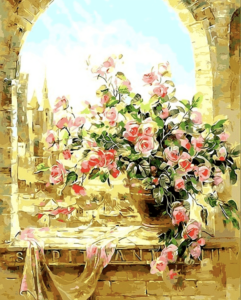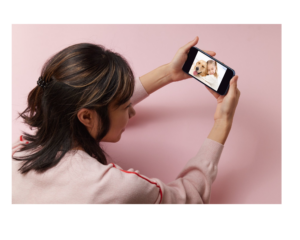Though you may not use it on your first kit, paint by numbers blending is a more advanced technique that promises fantastic results. It takes some getting used to as a beginner, but practice makes perfect, as they say!
Compared to blending acrylic paint on a canvas with no guidance, blending paint by numbers is easy. It’s a simple concept of matching each section with its number and color, but the finishing piece is just stunning.
Learning the best paint by numbers blending tips will help you create beautiful works of art worthy of their place in galleries. But first, let’s dive into what blending is all about and how it improves artwork from the get-go.
What Does Blending Paint Mean?
Blending sounds more complex than it is. The process itself is used by advanced artists or those with a little more experience than beginners. But once you get the hang of what you’re doing, it’s super easy to do.
Essentially, what you’re doing when blending paint is intermingling two or more colors of paint to create a gradual transition. For example, an ocean from dark blue to light blue and subtle hints of white. You can also play around with tones of red, fading them out to sunset colors. It depends on what you’re painting, but it’s so much easier with paint by numbers kits.
How to Blend Acrylic Paint
Before you start blending acrylic paints on canvas, you need to know what you’re doing and the best ways of doing it, too. Not only that, but you also need the correct tools and equipment to get started, otherwise, you run the risk of having to start over.
Acrylic paint blending is an advanced technique used by many artists, so it takes a little practice and getting used to. There are lots of acrylic paint blending techniques out there, but we’ve dwindled them down to the three easiest for beginners. Here’s how to blend acrylic paint and what you’ll need:
Blending Tools:
- Flat wash brush
- Watercolor paper (a few sheets)
- Acrylic paints
- Water
- Paint/color palette
Blending Techniques:
Technique #1: Wet on wet horizontal blending.
Pick two colors and gently blend using horizontal strokes. This technique is mostly used for skies, sunsets or covering an entire background – the trick is not washing your brush between colors! Simply start with the darkest color on your palette and work your way down the paper with lighter shades for a color-fade effect. Remember, the aim here is to let the colors overlap.
Technique #2: Wet on wet circular blending.
Pick two or more colors and gently blend in circular motions. Start with the lightest shade in the center of the page, and use darker colors as you brush outwards. When blending acrylic paint on canvas, always start with a white circle in the middle, then mix a light blue color on your palette.
Grab the same brush used to paint the white circle and dab on a little of the light blue color. Then, using circular strokes, apply the light blue paint around the white circle. Use just a drop of white to paint over where the blue and white transition. Keep doing this for each shade of blue you use!
Technique #3: Wet on wet double load.
Pick at least two colors to blend on your paper. Load your brush with the darkest color and dip the corner in white, then using the full width of the brush, paint up and down the paper. When you do this, remember to blend the white with your chosen color, but don’t fully merge the two! You can repeat this across the full width of the page. And just take your time with it – there’s no rush. You can even do some practice runs first.
Blending Paint by Numbers
Blending paint without instructions can be tricky if you’re new to paint palettes and artistry tools. But, blending paint by numbers is much easier as every kit comes with step-by-step instructions and everything you need to complete the painting. Here’s how to blend a paint by numbers painting:
- Step 1: pick two numbers from neighboring sections of the pre-printed canvas and find their associated colors.
- Step 2: take a little of each color and paste separately onto your color palette.
- Step 3: come down through the middle of the two colors with your brush, going back and forth until you have a new color palette. Be sure to load your brush in the right order, i.e. if orange is on the left, be sure to pick up orange on the left side of your brush.
- Step 4: take your brush with the mixed color and stroke down the line between your two chosen sections. This will add definition to your painting and hide any pre-printed lines that separate the colors.
Once you’ve completed all the steps above, give your painting time to dry. You’ll notice that the two colors blend much better and there’s no harsh lines between sections. By the end of it, your paint by numbers will look like a da Vinci piece!
Paint by Numbers Blending Tips
The most important rule to remember is to follow the instructions. They’re given to you for a reason, and without them, you might end up having to start over. And after all your hard work, starting from the beginning would be the worst! But, there are some things the instructions don’t tell you. So, here are some paint by numbers blending tips we think you’d like to know:
Tip #1: Don’t overpaint! There’s such a thing as trying too hard, so be careful not to use too much paint on your brush. Take it easy, you have plenty of time to blend and you can always come back to a section later.
Tip #2: Start with the lightest shades first, as these are normally the easiest. Look for the numbers and pick TWO sections, find their associated colors and remember the technique we mentioned earlier. You want your blended colors to look seamless, not patchy.
Tip #3: Pick an easy paint by number kit to start with. These tend to have the biggest sections with fewer numbers and paints, and some are even classed as kid’s paint kits, but it makes no difference. But remember to pick a print that you’re likely to enjoy, as this will help keep you motivated.
Tip #4: Have a selection of narrow and wide paint brushes at hand. Although the kits come with everything you could possibly need to complete the painting, having a choice of different brushes helps with blending. You can add more of each color with wider brushes, whereas with a narrow brush, you can add more intricate definition.
As long as you follow all the tips and tricks suggested in this blog, you’re set to master paint by numbers blending in no time.





